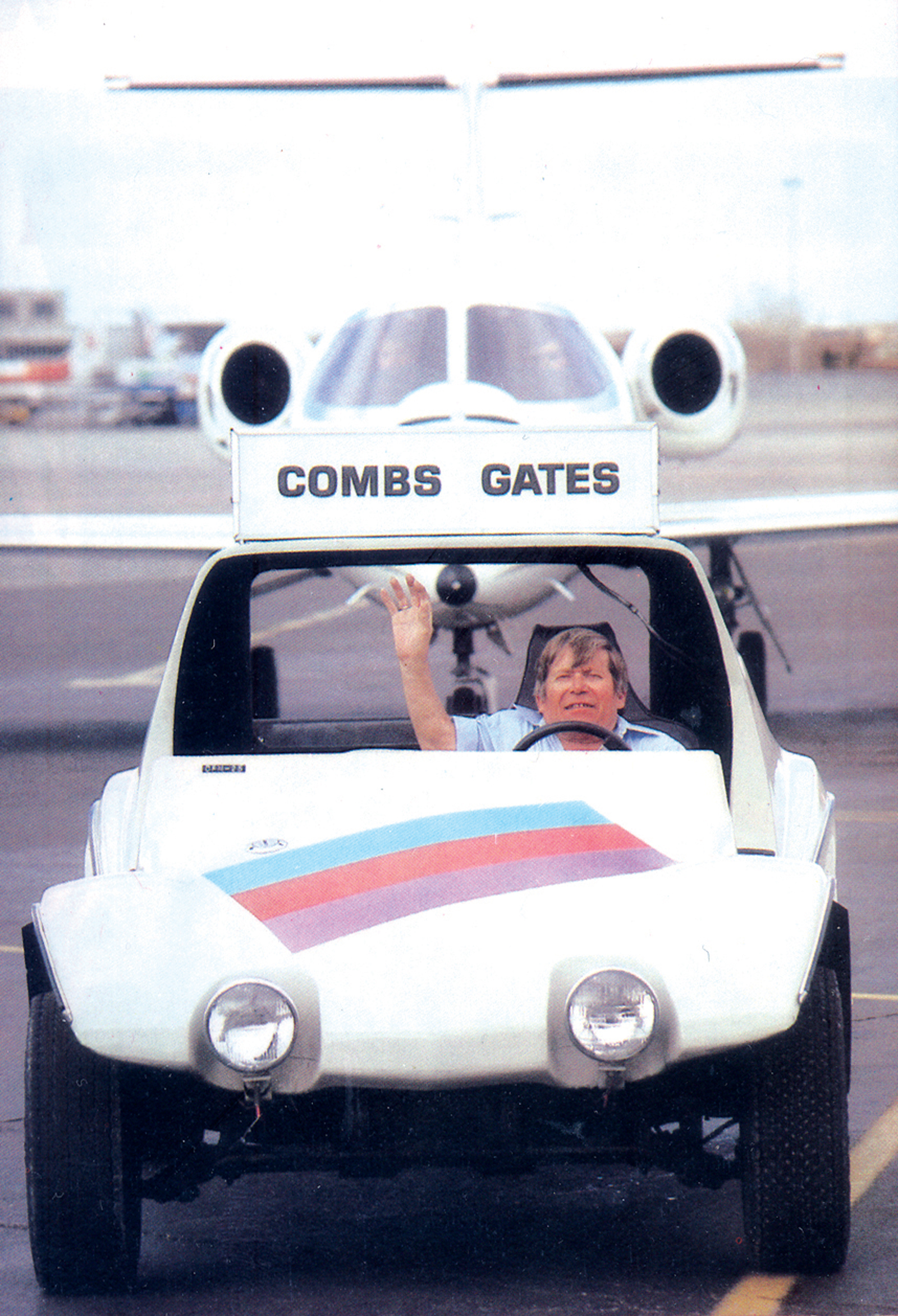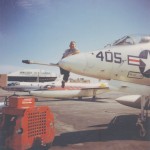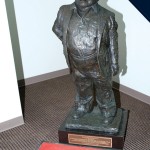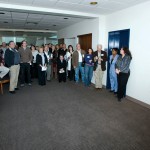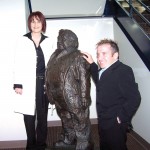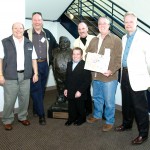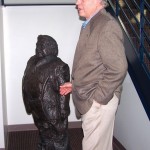By Bob Shane
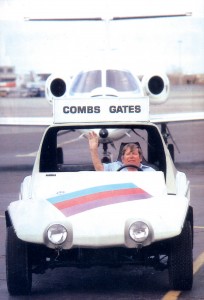
A common sight at Denver’s Stapleton Airport was J.J. Ingalls driving the Combs Gates “follow me” vehicle, with a corporate jet taxiing right behind him to its parking spot.
In aviation, many people have made meaningful contributions that have benefited the industry. One such person was Jimmie Joe Ingalls, who was born in North Platte, Neb., on July 26, 1932. His many friends affectionately called him “J.J.”
Afflicted with a genetic disorder, Ingalls only grew to a height of four feet, one inch. To taller people, he may have appeared to be handicapped, or in contemporary parlance, physically challenged. In reality, while Ingalls may have lacked physical stature, he was a giant when it came to character. He had a charismatic personality, an affinity for people, a big heart and sharp wit. When he talked about growing up in Colorado, he liked to tell people, with a smile on his face, “I was ‘reared,’ not ‘raised,’ because something went wrong with the dough and I didn’t ‘raise.'”
Related to true American pioneers, Ingalls’ ancestral tree includes frontier girl Laura Ingalls Wilder. Her autobiography, “Little House in the Big Woods,” was the basis for the Little House books and Michael Landon’s popular TV series, “Little House on the Prairie.”
Following high school, Ingalls worked at a variety of jobs. He became interested in watch repair and in 1952, graduated from the American Academy of Horology. He also held numerous side jobs working in sales and as a waiter. He was even a small town municipal judge and a stand-up comedian at Big Al’s Gas House Comedy Club, which was located in Denver.
It was after he got his first ride in an airplane that Ingalls discovered his true calling and passion was being around airplanes. He would beg rides from anyone who would fly him. From Aeronca Champs to Bamboo Bombers and DC-3s, it didn’t matter what it was as long as it had wings.
The Blue Onion

J.J. Ingalls and the Combs customer service girls would put on tuxedos three months during the year, in their effort to win the Pro Pilot PRASE Survey Award for Best FBO.
Ingalls became a regular patron of the Blue Onion bar and restaurant, which in the fifties and sixties was a popular Denver hangout for pilots and other aviation types. He was such a good customer that he had his own bar stool, complete with a seat belt fabricated from a surplus parachute. It proved to be an effective restraining device, keeping him from falling off during those occasions when he had a little too much to drink. While it’s true that he had a heart of gold, those who knew him say he could be a hell raiser.
The Blue Onion became an important influence in shaping his destiny. It was there that he met his future wife, Suzy, whom he married in October 1966. It was also at the Blue Onion, in 1961, that Ingalls met Don Sellers, the line manager for Combs Aviation. Knowing of Ingalls’ love for aviation, Sellers informed him that he had a line job in mind for him. He invited Ingalls to come out to the airport and meet the boss, Harry Combs.
During the interview, Combs told Ingalls, “We need someone to clean windshields.”
“A major concern of pilots was bugs and mosquitoes,” Ingalls recalled. “It was like pulling teeth to get the windshields cleaned.”
Although transient aircraft were being fueled, no one was cleaning the windows. The standard joke among the pilots was that they had to depart IFR because they couldn’t see out through the cockpit windows.
Working for Harry Combs

At his home in Mesa, Ariz., J.J. Ingalls holds up a treasured picture of himself taken with John Denver at one of Denver’s Christmas parties.
Ingalls accepted the position and went to work for Combs at Stapleton Airport. He immediately became the windshield-cleaning specialist.
“They got me a four-foot ladder at first,” Ingalls remembered. “As the airplanes got bigger, I just got a taller ladder.”
You might say that Ingalls was starting to immediately “move up the corporate jet ladder.” It wasn’t long before he went from cleaning windshields to driving the “follow me vehicle,” a ’56 Chevy station wagon used to marshal arriving aircraft to their designated parking spot on the Combs ramp. After an aircraft was parked, he would be the first FBO employee to meet the pilots and learn of their specific needs.
His pioneering stock soon took hold and he became the driving force for developing a formal customer service standard. Written checklists were devised and put into use. Combs became the first FBO in the industry to develop a customer service program, which it marketed to other FBOs. Many of those standards are in use today and the line service function has evolved into a profession requiring formal training.
Soon corporate pilots from all over America were getting to know Ingalls, the customer service specialist in Denver. Everyone admired what he was doing. His energy and work ethic inspired his fellow employees. Combs was becoming famous for its good service, with a major share of the credit going to Ingalls, who was starting to enjoy the recognition. Nothing made him feel better than the words, “J.J., you did a hell of a job. Thank you.”
During the period that he worked for Combs, it went through several ownership and name changes. The FBO became Combs Gates in 1966 and later AMR Combs.
Number one in customer service
Professional Pilot conducts annual industry surveys that recognize a variety of FBO services and products, including best employee, catering, fuel brand and weather service. Combs Gates ranked #1 U.S. FBO 12 times in the PRASE Survey and AMR Combs was the #1 U.S. FBO seven times. Ingalls was voted the #1 best FBO employee four years in a row. It’s no wonder he was called “Mr. Customer Service.”
Over the years, numerous celebrities were exposed to Ingalls’ charm. He had many stories about his experiences on the line taking care of the rich and famous, including presidents going back to Eisenhower, and famous actors and entertainers such as John Wayne, Frank Sinatra, Elvis Presley and John Denver.
On his 50th birthday, Willie Nelson was scheduled to depart Denver, headed for Austin. Ingalls decided to celebrate the occasion by decorating the inside of Nelson’s Learjet. With the help of Nelson’s flight crew, they put up signs that wished the entertainer a “Happy Birthday” and depicted a medley of his hit songs such as “Take this Job and Shove it.” Ingalls even arranged for a particular catering lady who Nelson had a fondness for to be there to greet him. Nelson was so overwhelmed by the gesture that he delayed his departure 30 minutes.
“That was one of the neat things that came out of the job,” Ingalls said. “Of course, Willie had to give up the Learjet when he settled with the IRS. There went his flight department.”
Friendship with Bill Daniels
Ingalls said that if you make one great friend in a lifetime, “you can feel very lucky.” He had that kind of friendship in entrepreneur Bill Daniels, often referred to as the “Father of Cable Television.” Headquartered in Denver, Daniels made the Mile High City the cable capital of the world. He was also a big sports fan and led the way in making sports programming an important part of the cable revolution.
Daniels was also a great humanitarian who believed successful people had a responsibility to help others who may not have had the same opportunities. He particularly admired entrepreneurs and people who were doing something inspiring. His generosity enabled many of them to achieve their dream.
A decorated Navy fighter pilot in World War II, Daniels destroyed 11 enemy aircraft and was awarded the Naval Cross, Air Medal and Distinguished Flying Cross. He also received the Bronze Star for heroism, following a kamikaze attack that targeted his ship, the aircraft carrier Intrepid. He later served in the Korean conflict and was on the demonstration team that was the prototype for the famed Blue Angels.
In civilian life, Daniels pioneered the use of corporate jets. With astronaut Pete Conrad on board, Daniels’ Learjet, “Cablevision Tool,” set an around-the-world speed record for a business jet.
Daniels kept his private jet hangared at Combs Aviation. It was there that Daniels and Ingalls met. Retelling the story of their earliest encounter, Ingalls recalled, “Daniels just flat-out said to me, “Where do you fit into this puzzle?” I said, “I don’t know, Mr. Daniels. I’m just the guy who will get you what you need.”
Daniels was impressed with Ingalls’ philosophy and work ethic. Over time a very special friendship developed between the two men.
Daniels liked to give people nicknames and he had a special name for Ingalls. One thing that Ingalls never allowed was for anyone to call him “Shorty.” There was, however, one exception.
“Bill Daniels was the only man who ever called me Shorty,” Ingalls said. “He did it out of respect. He called me J.J. around his business associates, but when we were one-on-one, it was always Shorty.”
The bond between these two men was strong. Ingalls would call Daniels for advice when he had to make a hard decision. Over the years, Daniels invited Ingalls on some of the trips he made in his Learjet, including the first corporate aircraft flight into the new Denver International Airport when it opened.
The retirement bash
After 29 years, Ingalls retired from AMR Combs (now Signature Flight Support, BBA Group’s service division) on Oct. 1, 1989. Bill Daniels threw him a retirement party that will never be forgotten. He invited 200 of Ingalls’ friends and relatives to the gala event at his “Cableland” mansion. For a retirement gift, Daniels commissioned renowned sculptor Kenneth Bunn to sculpt a life-size bronze sculpture of Ingalls. The sculpture was placed on display at AMR Combs, on the tarmac at the Denver Stapleton Airport. An enduring symbol of their friendship, the sculpture remained there on display until Stapleton closed.
Author’s note
As an aviation journalist, one gets to meet many prominent and successful people. Some have been captains of industry; others have been captains of state-of-the-art aircraft, risking life and limb to expand the envelope of flight. They have all been interesting, but I can’t recall ever having a more gratifying encounter than my interview with Jimmie Joe Ingalls. I consider myself fortunate to have had the opportunity to learn what an exceptional man he was. The more we talked, the more I began to see those same lofty qualities in him that Bill Daniels had discovered many years ago. While we sat together in his home in Mesa, Ariz., on Feb. 25, 2006, neither of us knew that he had less than five days to live. He had colon cancer and was living life one day at a time.

TAC Air Denver General Manager Dan Bryant reminisces about J.J. Ingalls at the sculpture dedication. Sadly, Ingalls died March 2, on the morning of the dedication.
J.J. Ingalls had one last thing to do before he passed away. That was to return to the Denver area for a dedication at TAC Air at Centennial Airport, the new home of his sculpture, on March 2, 2006. Unfortunately, after our interview, his health took a turn for the worst and he wasn’t up to making the trip to Denver. As fate would have it, time had run out. He passed away the morning of March 2 in Arizona, at the age of 73.
The sculpture dedication went on as scheduled. Approximately 75 people, including his son, Victor Ingalls, and his wife Lisa, were in attendance. A memorial service was also held on March 16 at the Daniels Foundation.
Jimmie Joe Ingalls turned what most people regard as a handicap into an asset. He became the most recognized “follow me” person in aviation. By making that extra effort to provide superior customer service, he rose to the top of his chosen vocation and made a lot of friends along the way. He will always be remembered for his contribution to aviation.
- When the work was done, J.J. Ingalls wasn’t above having some fun, such as posing for a picture while sitting on the refueling probe of a Navy A-4 Skyhawk parked on the Combs ramp.
- A common sight at Denver’s Stapleton Airport was J.J. Ingalls driving the Combs Gates “follow me” vehicle, with a corporate jet taxiing right behind him to its parking spot.
- J.J. Ingalls displays the coveted plaque he received from Pro Pilot naming him the #1 Best FBO Employee for 1987.
- When J.J. Ingalls retired from AMR Combs, cable pioneer Bill Daniels commissioned Kenneth Bunn to create a life-size bronze sculpture of Ingalls. The sculpture was displayed at AMR Combs at Stapleton Airport. Its new home is TAC Air Denver, at Centennial
- Dan Bryant addresses those gathered to honor J.J. Ingalls.
- Above: J.J. Ingalls’ son Victor Ingalls and his wife Lisa made a special trip from Scottsdale, Ariz., to be at TAC Air Denver for the sculpture dedication.
- L to R: Denver jetCenter GM Chuck Halderman, Dave Barry of Barry Productions, Victor Ingalls, Michael Dye (owner of Harrison Jet Center), Pat O’Connor (former manager of the Galley at Combs) and Randy Bisgard (senior VP of Airport Business Solutions).
- Above: Kenneth Bunn, who sculpted the bronze image of J.J. Ingalls, was a good friend of Bill Daniels and J.J. and Suzy Ingalls.











